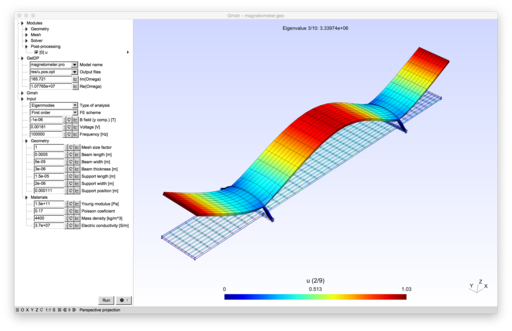Difference between revisions of "Magnetometer"
(→Additional information) |
|||
| Line 3: | Line 3: | ||
== Additional information == | == Additional information == | ||
| − | To run the | + | |
| + | This is a 3D, multiphysics model of a MEMS magnetometer, coupling electromagnetic (electrokinetic), mechanichal (elastic) and thermal models. To run the model, open '''magnetometer.pro''' with Gmsh. | ||
| + | |||
| + | When an alternating current flows through it, the magnetometer starts to vibrate if it is placed in a magnetic field. The amplitude of the vibration can be used to measure the magnetic field. To increase sensitivity, the frequency of the current is tuned to excite a resonant mode of the xylophone-type structure. Several analyses are predefined: uncoupled modal analysis of the structure ('''Eigenmodes''') and calculation of the current flow ('''Electrokinetics'''), static and dynamic electro-mechanical analysis ('''Electro-mechanical'''), and coupled electro-thermal analysis ('''Electro-thermal'''). | ||
{{metamodelfooter|magnetometer}} | {{metamodelfooter|magnetometer}} | ||
Latest revision as of 16:42, 29 November 2015
|
Xylophone bar magnetometer.
|
 
|
|---|
|
Download model archive (magnetometer.zip) |
Additional information
This is a 3D, multiphysics model of a MEMS magnetometer, coupling electromagnetic (electrokinetic), mechanichal (elastic) and thermal models. To run the model, open magnetometer.pro with Gmsh.
When an alternating current flows through it, the magnetometer starts to vibrate if it is placed in a magnetic field. The amplitude of the vibration can be used to measure the magnetic field. To increase sensitivity, the frequency of the current is tuned to excite a resonant mode of the xylophone-type structure. Several analyses are predefined: uncoupled modal analysis of the structure (Eigenmodes) and calculation of the current flow (Electrokinetics), static and dynamic electro-mechanical analysis (Electro-mechanical), and coupled electro-thermal analysis (Electro-thermal).
|
Model developed by V. Rochus, I. Niyonzima, C. Geuzaine.
|

